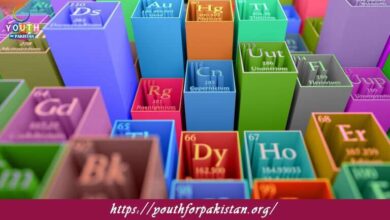9th Class Physics Chapter 5 MCQs with Answers

Turning Effects of Force 9th Class Physics Chapter 5 MCQs focuses on the turning effects of force also known as torque. The chapter teaches how forces produce rotation, and what a lever arm, what is torque and when does rotational equilibrium occur. Practice MCQ’s on Turning Effects of Force.
Core Topics in Turning Effects of Force
The concept of torque and usage in daily life is in tools and machines. These are pretty commonly tested in the MCQs on Turning Effects of Force, so this is quite important knowledge for the exam.
The turning effect produced by a force about a point or axis is known as:
a) Momentum
b) Torque
c) Inertia
d) Gravitational force
The turning effect of a force depends on the magnitude of the force and the:
a) Distance between the force and the point of rotation
b) Speed of the object
c) Mass of the object
d) Direction of the force
The turning effect produced by a force is maximum when the force is applied:
a) Perpendicular to the line of action
b) In the opposite direction of motion
c) Along the line of action
d) At an angle of 45 degrees to the line of action
What is the SI unit of torque?
a) Newton (N)
b) Joule (J)
c) Watt (W)
d) Newton-meter (N·m)
If a force of 10 N is applied at a distance of 2 meters from the point of rotation, what is the torque produced?
a) 20 N
b) 5 N
c) 8 N·m
d) 15 N·m
Which of the following factors does not affect the torque produced by a force?
a) Magnitude of the force
b) Distance from the point of rotation
c) Direction of the force
d) Speed of the object
A force of 20 N is applied at a distance of 5 meters from the point of rotation. What is the torque produced?
a) 4 N
b) 25 N
c) 100 N·m
d) 5 N·m
The turning effect of a force is maximum when the force is applied:
a) Perpendicular to the line of action
b) In the opposite direction of motion
c) Along the line of action
d) At an angle of 90 degrees to the line of action
The length of the lever arm is the distance between the:
a) Force and the point of rotation
b) Point of rotation and the object
c) Force and the object
d) Object and the surface
The turning effect produced by a force is called torque. Torque is also known as:
a) Moment of force
b) Kinetic energy
c) Centripetal force
d) Impulse
The moment of a force about a point is defined as the:
a) Product of the force and distance
b) Product of the force and time
c) Ratio of force and displacement
d) Ratio of force and velocity
If a force of 8 N is applied at a distance of 2 meters from the point of rotation, what is the torque produced?
a) 4 N
b) 16 N
c) 12 N·m
d) 6 N·m
The turning effect of a force depends on the magnitude of the force and the:
a) Distance between the force and the point of rotation
b) Speed of the object
c) Mass of the object
d) Direction of the force
A force of 15 N is applied at a distance of 3 meters from the point of rotation. What is the torque produced?
a) 5 N
b) 18 N
c) 45 N·m
d) 30 N·m
The turning effect produced by a force is maximum when the force is applied:
a) Perpendicular to the line of action
b) In the opposite direction of motion
c) Along the line of action
d) At an angle of 60 degrees to the line of action
What is the SI unit of torque?
a) Newton (N)
b) Joule (J)
c) Watt (W)
d) Newton-meter (N·m)
If a force of 10 N is applied at a distance of 2 meters from the point of rotation, what is the torque produced?
a) 20 N
b) 5 N
c) 8 N·m
d) 15 N·m
Which of the following factors does not affect the torque produced by a force?
a) Magnitude of the force
b) Distance from the point of rotation
c) Direction of the force
d) Speed of the object
A force of 20 N is applied at a distance of 5 meters from the point of rotation. What is the torque produced?
a) 4 N
b) 25 N
c) 100 N·m
d) 5 N·m
The turning effect of a force is maximum when the force is applied:
a) Perpendicular to the line of action
b) In the opposite direction of motion
c) Along the line of action
d) At an angle of 90 degrees to the line of action
The length of the lever arm is the distance between the:
a) Force and the point of rotation
b) Point of rotation and the object
c) Force and the object
d) Object and the surface
The turning effect produced by a force is called torque. Torque is also known as:
a) Moment of force
b) Kinetic energy
c) Centripetal force
d) Impulse
The moment of a force about a point is defined as the:
a) Product of the force and distance
b) Product of the force and time
c) Ratio of force and displacement
d) Ratio of force and velocity
If a force of 8 N is applied at a distance of 2 meters from the point of rotation, what is the torque produced?
a) 4 N
b) 16 N
c) 12 N·m
d) 6 N·m
The turning effect of a force depends on the magnitude of the force and the:
a) Distance between the force and the point of rotation
b) Speed of the object
c) Mass of the object
d) Direction of the force
A force of 15 N is applied at a distance of 3 meters from the point of rotation. What is the torque produced?
a) 5 N
b) 18 N
c) 45 N·m
d) 30 N·m
The turning effect produced by a force is maximum when the force is applied:
a) Perpendicular to the line of action
b) In the opposite direction of motion
c) Along the line of action
d) At an angle of 60 degrees to the line of action
What is the SI unit of torque?
a) Newton (N)
b) Joule (J)
c) Watt (W)
d) Newton-meter (N·m)
If a force of 10 N is applied at a distance of 2 meters from the point of rotation, what is the torque produced?
a) 20 N
b) 5 N
c) 8 N·m
d) 15 N·m
Which of the following factors does not affect the torque produced by a force?
a) Magnitude of the force
b) Distance from the point of rotation
c) Direction of the force
d) Speed of the object
A force of 20 N is applied at a distance of 5 meters from the point of rotation. What is the torque produced?
a) 4 N
b) 25 N
c) 100 N·m
d) 5 N·m
The turning effect of a force is maximum when the force is applied:
a) Perpendicular to the line of action
b) In the opposite direction of motion
c) Along the line of action
d) At an angle of 90 degrees to the line of action
The length of the lever arm is the distance between the:
a) Force and the point of rotation
b) Point of rotation and the object
c) Force and the object
d) Object and the surface
The turning effect produced by a force is called torque. Torque is also known as:
a) Moment of force
b) Kinetic energy
c) Centripetal force
d) Impulse
The moment of a force about a point is defined as the:
a) Product of the force and distance
b) Product of the force and time
c) Ratio of force and displacement
d) Ratio of force and velocity
If a force of 8 N is applied at a distance of 2 meters from the point of rotation, what is the torque produced?
a) 4 N
b) 16 N
c) 12 N·m
d) 6 N·m
The turning effect of a force depends on the magnitude of the force and the:
a) Distance between the force and the point of rotation
b) Speed of the object
c) Mass of the object
d) Direction of the force
A force of 15 N is applied at a distance of 3 meters from the point of rotation. What is the torque produced?
a) 5 N
b) 18 N
c) 45 N·m
d) 30 N·m
The turning effect produced by a force is maximum when the force is applied:
a) Perpendicular to the line of action
b) In the opposite direction of motion
c) Along the line of action
d) At an angle of 60 degrees to the line of action
What is the SI unit of torque?
a) Newton (N)
b) Joule (J)
c) Watt (W)
d) Newton-meter (N·m)
If a force of 10 N is applied at a distance of 2 meters from the point of rotation, what is the torque produced?
a) 20 N
b) 5 N
c) 8 N·m
d) 15 N·m
Which of the following factors does not affect the torque produced by a force?
a) Magnitude of the force
b) Distance from the point of rotation
c) Direction of the force
d) Speed of the object
A force of 20 N is applied at a distance of 5 meters from the point of rotation. What is the torque produced?
a) 4 N
b) 25 N
c) 100 N·m
d) 5 N·m
The turning effect of a force is maximum when the force is applied:
a) Perpendicular to the line of action
b) In the opposite direction of motion
c) Along the line of action
d) At an angle of 90 degrees to the line of action
The length of the lever arm is the distance between the:
a) Force and the point of rotation
b) Point of rotation and the object
c) Force and the object
d) Object and the surface
The turning effect produced by a force is called torque. Torque is also known as:
a) Moment of force
b) Kinetic energy
c) Centripetal force
d) Impulse
The moment of a force about a point is defined as the:
a) Product of the force and distance
b) Product of the force and time
c) Ratio of force and displacement
d) Ratio of force and velocity
If a force of 8 N is applied at a distance of 2 meters from the point of rotation, what is the torque produced?
a) 4 N
b) 16 N
c) 12 N·m
d) 6 N·m
The turning effect of a force depends on the magnitude of the force and the:
a) Distance between the force and the point of rotation
b) Speed of the object
c) Mass of the object
d) Direction of the force
A force of 15 N is applied at a distance of 3 meters from the point of rotation. What is the torque produced?
a) 5 N
b) 18 N
c) 45 N·m
d) 30 N·m
The turning effect produced by a force is maximum when the force is applied:
a) Perpendicular to the line of action
b) In the opposite direction of motion
c) Along the line of action
d) At an angle of 60 degrees to the line of action
If you are interested to enhance your knowledge regarding Physics, Chemistry, Biology, and Computer please click on the link of each category, you will be redirected to dedicated website for each category.





